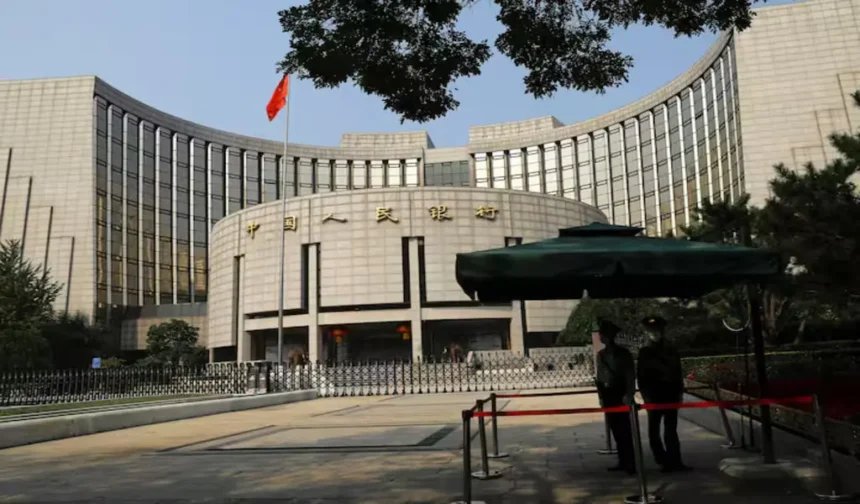In January, the Central Bank of China exceeded expectations by increasing the volume of new bank loans to a record high.
This increase was a response to the economy’s shaky recovery, which is anticipated to be further exacerbated by the impending U.S. tariffs. As a result, there is a growing expectation for additional stimulus in the months ahead.
On Friday, the People’s Bank of China released data indicating that Chinese banks extended 5.13 trillion yuan ($706.40 billion) in new yuan loans in January, surpassing analysts’ predictions and more than quadrupling the December figure.
Last month, analysts surveyed by Reuters anticipated that new yuan loans would increase to 4.5 trillion yuan, a significant increase from the previous record of 4.92 trillion yuan set a year earlier.
Typically, China banks are eager to lend at the start of the year in order to compete for higher-quality consumers and gain market share. However, analysts have warned that the demand for credit is still being influenced by persistent economic uncertainty.
“The headline figures for new local currency loans in January reached a record high, but this is primarily due to the typical seasonal pattern.” Capital Economics stated in a note that net lending was consistently at its most robust at the beginning of the year.
China’s Economic Stimulus Plans: Fiscal Spending and Monetary Easing
“The growth of bank loans continued to decline to record lows, but this was counterbalanced by an increase in non-bank credit growth.” In the forthcoming quarters, credit growth is expected to be sustained by robust government bond issuance. However, credit growth will likely remain subdued due to lacklustre private demand.
According to central bank data, household loans, which include mortgages, increased from 350 billion yuan in December to 443.8 billion yuan in January, while corporate loans increased from 490 billion yuan to 4.78 trillion yuan.
Last year, new bank lending totalled 18.09 trillion yuan, a decrease from the record-breaking 22.75 trillion yuan in 2023 and the lowest level since 2019, as businesses and consumers remained hesitant to incur additional debt in the face of an uncertain economic outlook.
The government’s official objective of a 5% growth in the economy in 2024 was achieved; however, the post-pandemic recovery has been inconsistent, with exports and manufacturing compensating for lacklustre domestic consumption.
Analysts are uncertain about the speed at which policymakers can revitalise lethargic domestic demand, even though U.S. President Donald Trump’s punitive trade measures are increasing the pressure on Chinese exporters. Beijing is anticipated to maintain a growth target of approximately 5% this year.
Beijing has committed to raising fiscal spending, increasing debt issuance, and further monetary easing in order to maintain growth and mitigate increasing external pressures.
In the face of increasing external headwinds, the central bank announced on Thursday that it would modify its monetary policy at the appropriate time and employ policy tools such as interest rates and bank reserve requirement ratios (RRR) to support the economy.
Following President Donald Trump’s imposition of comprehensive 10% tariffs on all Chinese imports, China is currently embroiled in a renewed trade conflict with the United States.
Beijing responded by imposing tariffs of up to 15% on certain U.S. imports, effective February 10.
Nevertheless, the measures implemented thus far have been more modest than anticipated by the markets, which has sparked optimism that there is potential for negotiation.
Beijing has intensified its efforts to restore the economy since September. These efforts have included interest rate reductions, a 10 trillion yuan debt relief program for local governments, and tax incentives to stimulate demand in the crisis-affected property market.
Analysts anticipate that the central bank will implement additional reductions in interest rates and RRR as early as the first quarter, despite its unwavering commitment to the yuan currency in response to Trump’s threats.
Investors are anticipating the annual parliament meeting in March, during which the government is anticipated to disclose new stimulus measures and economic objectives.
In January, outstanding yuan loans increased by 7.5% from the previous year, the lowest rate on record, in response to concerns regarding credit demand. This rate was lower than the 7.6% rate observed in December. According to analysts, growth was anticipated to be 7.3%.
According to the central bank data, the broad M2 money supply increased by 7.0% from the previous year, which was lower than the 7.2% forecast by analysts in a Reuters poll. M2 expanded by 7.3% in December.
In January, the M1 money supply, which is more restricted, increased by 0.4% from the previous year, in contrast to a 1.4% decline in December.
In January, the central bank incorporated personal demand deposits and non-bank payment institutions’ client provisions into M1, which had previously only included currency in circulation and corporate demand deposits.
In January, the annual growth rate of outstanding total social financing (TSF), which is a comprehensive indicator of credit and liquidity in the economy, remained at 8.0%, as it did in December.
An increase in the issuance of government bonds to stimulate the economy could potentially assist in the acceleration of TSF growth.
TSF encompasses off-balance sheet financing methods that are not part of the traditional bank lending system, including bond sales, initial public offerings, and loans from trust corporations.
TSF increased from 2.86 trillion yuan in December to 7.06 trillion yuan in January. Reuters surveyed analysts who anticipated a total of 6.4 trillion yuan.

Salman Ahmad is known for his significant contributions to esteemed publications like the Times of India and the Express Tribune. Salman has carved a niche as a freelance journalist, combining thorough research with engaging reporting.














